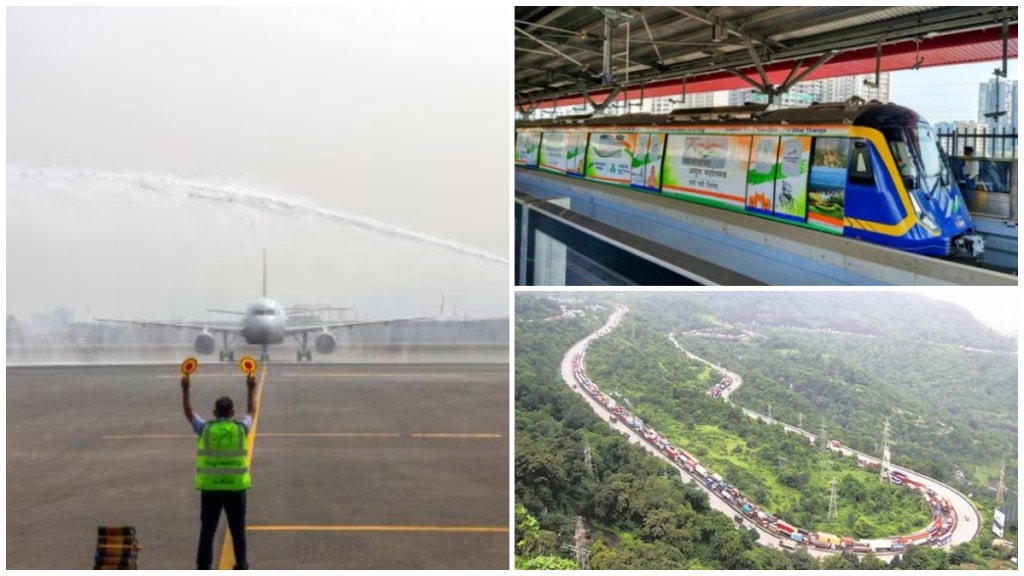As we step into 2025, Mumbai is on the verge of a remarkable transformation. Major infrastructure projects, including the city’s first underground metro, India’s largest greenfield expressway, and a state-of-the-art international airport, are set to revolutionise urban mobility and connectivity. These ambitious developments promise to enhance travel efficiency, ease congestion, and support the city’s growth like never before. From faster commutes to improved global access, Mumbai is gearing up for a new era of innovation and progress. Let’s explore these upcoming and groundbreaking initiatives that will reshape Mumbai’s transportation system and redefine its future.
Navi Mumbai International Airport: A New Gateway to the Skies
Marking a historic milestone, the Navi Mumbai International Airport (NMIA) will be inaugurated on April 17, 2025. With domestic flights launching in May and international operations by July, NMIA will alleviate the heavy traffic at the Chhatrapati Shivaji Maharaj International Airport. Initially designed to accommodate 20 million passengers annually, the airport plans to expand its capacity to 50 million by 2029, enhancing connectivity and offering a seamless travel experience for the Mumbai Metropolitan Region (MMR).
Metro Line 3: Mumbai’s Underground Revolution
The much-anticipated Metro Line 3, connecting Colaba to SEEPZ via Bandra, is set to become fully operational by the end of 2025. Spanning 33.5 km, this underground metro will provide a faster, air-conditioned alternative to the city’s crowded local trains. With reduced travel times and enhanced connectivity, Metro Line 3 is poised to transform the daily commute for millions of Mumbaikars.
Mumbai-Pune Expressway Missing Link: Smoother Travel Ahead
By June 2025, the Missing Link project on the Mumbai-Pune Expressway will revolutionize travel between the two cities. Reducing the distance by 6 km, this project, complete with tunnels and cable-stayed bridges, will cut travel time by 25 minutes, offering a faster and more efficient route.
Samruddhi Mahamarg: A High-Speed Highway for the Future
The Samruddhi Mahamarg, a 701-km expressway linking Mumbai and Nagpur, will be fully operational by mid-2025. The final stretch from Igatpuri to Thane will bypass the challenging Kasara Ghat section, slashing travel time between the two cities to just 8 hours from the current 12. This ambitious project promises to boost trade, logistics, and connectivity in the region, opening up new avenues for economic growth.
Ballard Pier Cruise Terminal: Mumbai’s Global Cruise Hub
Mumbai will soon emerge as a leading destination for cruise tourism with the launch of the Ballard Pier Extension (BPX) terminal. Set to open in 2025, BPX is designed to handle up to 500 cruises annually, welcoming approximately 1 million passengers. This modern terminal is expected to bolster Mumbai’s position as a key player in international tourism.
SCLR Extension: Connecting the City’s Heart
The Santacruz-Chembur Link Road (SCLR) Extension, scheduled for completion in early 2025, will bridge Kurla to the Western Express Highway at Vakola Junction. This 4.2-km stretch aims to decongest key areas like BKC and Vakola, making daily commutes smoother and faster.
Mumbai-Ahmedabad Bullet Train Project
India’s first bullet train, the Mumbai-Ahmedabad High-Speed Rail corridor, will span 508 kilometers, providing quick and efficient travel between Maharashtra and Gujarat. Starting from Bandra Kurla Complex (BKC) in Mumbai, this high-speed train, traveling at 320 km/h, will transform intercity commuting and strengthen the economies of key cities like Mumbai, Surat, Vadodara, and Ahmedabad. The train will make stops in 10 cities, including Thane, Virar, Boisar, Surat, and more, before ending its journey at Sabarmati. With limited stops in Surat, Vadodara, and Ahmedabad, the entire trip will take just 2 hours and 7 minutes, offering a much faster alternative to traditional trains and road travel.
Airoli-Katai Naka Tunnel Road: A Boost for Eastern Suburbs
Expected to be completed in 2025, the Airoli-Katai Naka Road will connect Airoli to the Kalyan-Shilphata corridor. This six-lane road is set to cut down travel time between Airoli and Shilphata, improving connectivity in the eastern suburbs.
Panvel-Karjat Rail Corridor: Faster Rail Connections
The Panvel-Karjat Rail Corridor, part of the Mumbai Urban Transport Project (MUTP-3), will be completed by December 2025. This 29.6-km line will reduce travel time from Karjat to South Mumbai to just 1.5 hours, enhancing access to major business hubs like Vashi and Airoli.
Three New Bridges for a Seamless Commute
Three new bridges—Carnac Bridge, Vikhroli Road Over Bridge (ROB), and Bellasis Bridge—are set to improve traffic flow across Mumbai. The Carnac and Vikhroli Bridges will open by May 2025, while the Bellasis Bridge is scheduled for completion by October 2025, easing congestion in key areas.
Goregaon-Mulund Link Road: Bridging the Suburban Divide
The ambitious Goregaon-Mulund Link Road (GMLR) project will see significant progress in August 2025 with the commencement of twin tunnel boring. Once completed in 2028, this 12-km road will cut travel time between Mulund and the Western Express Highway from 90 minutes to just 25 minutes, greatly enhancing connectivity between Mumbai’s western and eastern suburbs.
Mumbai’s journey into 2025 is marked by groundbreaking infrastructure projects that promise to redefine its urban landscape. As these initiatives come to fruition, the city will move closer to a future of seamless travel, improved connectivity, and sustainable growth.

